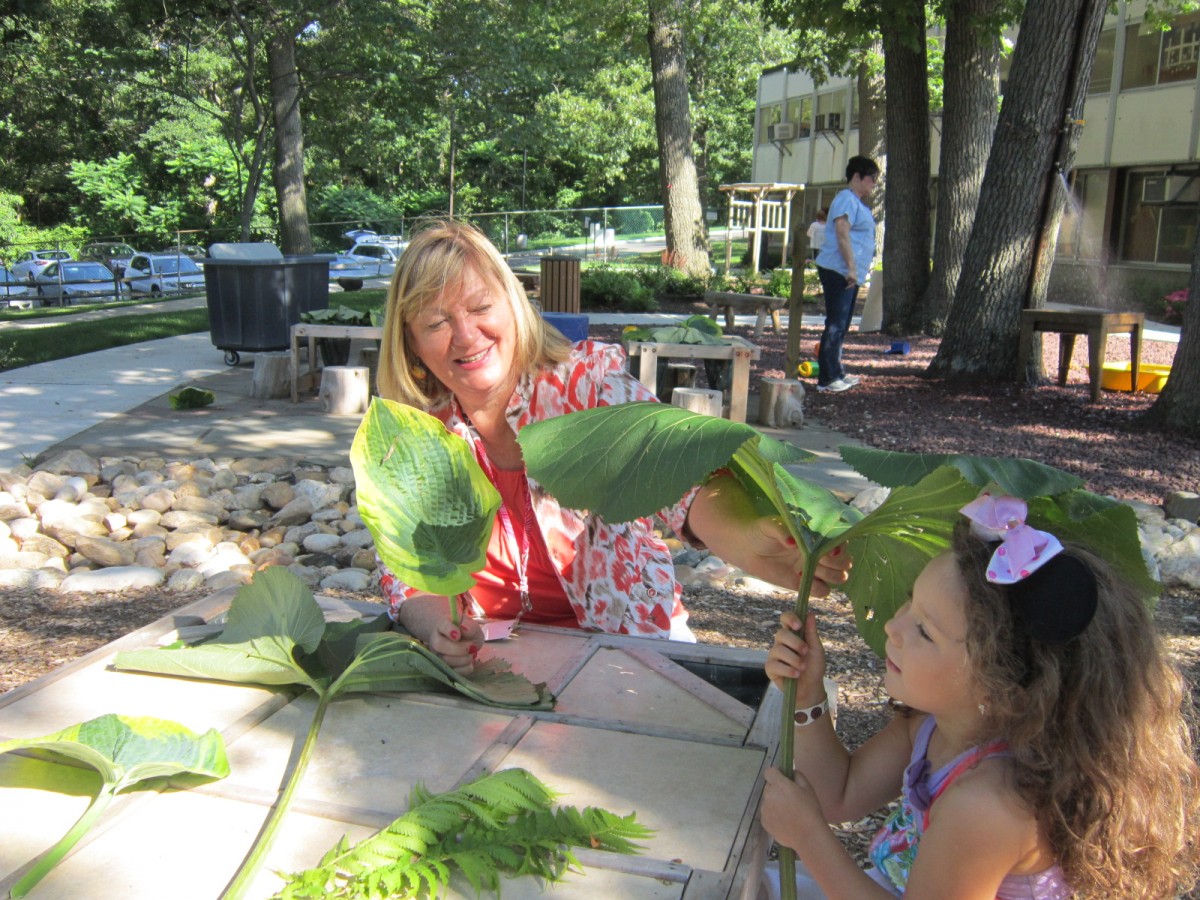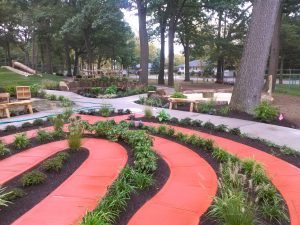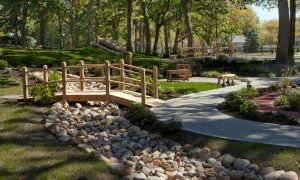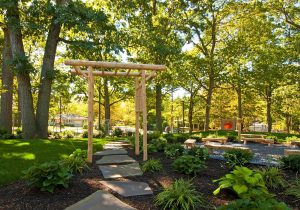At the Developmental Disabilities Institute — Experiencing is Believing

The Developmental Disabilities Institute (DDI), founded in 1961 to serve children, now has 39 sites across Long Island, New York. DDI’s 1600 employees work in a variety of educational, vocational, medical and residential programs, with people of all ages. Dr. Linda Whitaker, Director of the Starting Early Program, oversees two preschools serving children with a range of developmental disabilities, and typically developing children, as well. Both preschools have Nature Explore Classrooms.
A few years ago the playgrounds in the Starting Early Program needed renovation. Linda formed a team of teachers, and Physical and Occupational Therapists to visit various local outdoor spaces for children. A Physical Therapist herself, Linda knew that she didn’t want the typical playground of climbing equipment, swing sets and safety flooring. She had researched the Nature Explore website and was intrigued by the possibilities of an outdoor classroom.
Yet traditional playgrounds were the only kinds of children’s outdoor space that many of her staff had known. Linda says that they thought, ‘You couldn’t survive without swings. You couldn’t survive without slides.’ At the end of a long day of visiting many sites, the team had one last stop.
“As soon as we got to Computer Associates and toured their [Nature Explore] outdoor classroom, they were on board. “ The team’s reaction was, “This is amazing. It’s an amazing learning environment.”
Linda said, “Immediately as soon as you walk on it, you’re calm, you let out a deep breath—and so from there we moved forward.”
 Linda’s words from her statement for the DDI page on the Nature Explore web site, “We had a one-acre wooded area that had a major run-off gully with an old climbing structure and large areas where the grass would not grow. In the winter of 2014 a designer from the Nature Explore program came to our site for two days to help design an outdoor classroom that would meet the special needs of our students. The team consisted of a Special Education Teacher, Education Behavior Specialist, Physical Therapist, Occupational Therapist and School Administrator… The plan incorporated our natural landscape and the run-off gully became a dry rock river bed that meanders through the outdoor space and is a major feature of our outdoor classroom. We added a walking labyrinth to provide a place for students to go and be quiet and calm.”
Linda’s words from her statement for the DDI page on the Nature Explore web site, “We had a one-acre wooded area that had a major run-off gully with an old climbing structure and large areas where the grass would not grow. In the winter of 2014 a designer from the Nature Explore program came to our site for two days to help design an outdoor classroom that would meet the special needs of our students. The team consisted of a Special Education Teacher, Education Behavior Specialist, Physical Therapist, Occupational Therapist and School Administrator… The plan incorporated our natural landscape and the run-off gully became a dry rock river bed that meanders through the outdoor space and is a major feature of our outdoor classroom. We added a walking labyrinth to provide a place for students to go and be quiet and calm.”
This, the first of DDI’s outdoor classrooms, opened in Huntington, NY in 2014. Yet, during construction, one final hurdle presented itself. It was easily overcome.
“Even my employees…over a hundred working at the special education preschool, people couldn’t understand it. ‘Why aren’t we having the swings, why aren’t we having the slides?” Again, as soon as the staff actually experienced the space, they were won over.
So many times we’ve seen early childhood professionals who are initially skeptical of the outdoor classroom concept. Usually their only experience with outdoor spaces at schools has been the traditional playground. Also, many are from the generations that didn’t have strong histories of childhood play in nature. The DDI staff’s initial hesitancy to embrace the unknown is especially understandable considering that they work with children with special developmental needs.
Those of us who work with or in Nature Explore Classrooms, have seen that the necessary ingredient for the adoption of the outdoor classroom concept is the visionary. This is the leader who can step out of common experience to investigate the unknown. Linda was that person at DDI. And her staff deserves kudos for trying, then also embracing, the unknown.
And embrace the outdoor classroom concept they did. No sooner had the DDI staff begun using their new space in Huntington, then the plans got underway for another, at their Ronkonkoma location.
DDI’s outdoor classrooms are places where what’s done indoors can be done outside. Although the spaces are used for free play, they are also used for lessons. Sometimes the two kinds of learning are combined. The Messy Materials areas often feature intentionally placed objects that are related to the seasons. Free play with them, with scaffolding by teachers, inspires learning about seasons effortlessly.
Linda is working to get some classes to spend entire mornings outside, and she intends the space to be used throughout the winter. Circle time, classes, even physical and occupational therapy are conducted outside.
The outdoor classroom provides excellent terrain for emerging walkers. Occupational Therapy is enhanced by the variety of surfaces the child experiences. In contrast to the uniform, spongy surface of many traditional playgrounds, the outdoor classroom offers cement, wood chips, gravel and grass. “If you want to be able to walk you have to learn to negotiate all these different surfaces,” says Linda. “It’s fabulous for these kids.”
 Many who don’t have direct experience with children who have developmental disabilities might think that the Nature Explore Classroom would need major accessibility modifications. Each site planned by the Nature Explore design team is configured for its specific location, and in conjunction with the people who will be using it. Much traditional playground equipment, modified for accessibility is predesigned. The Nature Explore classroom uses research-approved ideas, yet its actual execution is not predesigned. As Linda said, “With an outdoor classroom- that’s the beauty of it. You don’t have to make many huge modifications to accommodate students with disabilities.” The major accessibility feature at the Huntington site is an extra wide concrete path through the classroom to ensure that children using wheelchairs can get anywhere they want to go. “I don’t have any children that are not able to use the outdoor classroom and get benefits from it,” said Linda.
Many who don’t have direct experience with children who have developmental disabilities might think that the Nature Explore Classroom would need major accessibility modifications. Each site planned by the Nature Explore design team is configured for its specific location, and in conjunction with the people who will be using it. Much traditional playground equipment, modified for accessibility is predesigned. The Nature Explore classroom uses research-approved ideas, yet its actual execution is not predesigned. As Linda said, “With an outdoor classroom- that’s the beauty of it. You don’t have to make many huge modifications to accommodate students with disabilities.” The major accessibility feature at the Huntington site is an extra wide concrete path through the classroom to ensure that children using wheelchairs can get anywhere they want to go. “I don’t have any children that are not able to use the outdoor classroom and get benefits from it,” said Linda.
At Starting Early all the children, both with and without developmental disabilities do what children do naturally when outdoors—they play. Linda says, “A child with a disability is not any different than typically developing children except for their needs. They take longer. They need more direct instruction— but the whole experience… the kids go out and they love it. They love taking buckets of water… and watering the plants. If we have a four year old who is functioning like a three year old, it’s the same as if you’d take a three year old out there. And the concern with children with autism, who have very short attention spans—they’re different when they go to the outdoor classroom. They enjoy… exploring and playing with the sand and building in the block area.” Clearly, some children who might otherwise be intimidated from playing freely in a traditional playground are at home in a Nature Explore Classroom.
 We are delighted that Linda Whitaker and her dedicated staff chose to “go with nature” when overhauling the outdoor areas of the Starting Early Program. Their experience illustrates many rare facets of this transformational experience. Caring professionals, working with special needs children, can easily overcome the “apprehension of the unknown” that is often the first reaction to such radical change. For the staff at DDI, “seeing was believing” (or experiencing was believing). Exposure to a Nature Explore Classroom changed hearts and minds quickly.
We are delighted that Linda Whitaker and her dedicated staff chose to “go with nature” when overhauling the outdoor areas of the Starting Early Program. Their experience illustrates many rare facets of this transformational experience. Caring professionals, working with special needs children, can easily overcome the “apprehension of the unknown” that is often the first reaction to such radical change. For the staff at DDI, “seeing was believing” (or experiencing was believing). Exposure to a Nature Explore Classroom changed hearts and minds quickly.
As always, the Nature Explore design process involves input from adults who know the children who will use the space. Other “playground designs” couldn’t involve this close a level of design input because the equipment is already predesigned.
The Starting Early preschools serve children with developmental disabilities, and typically developing students, as well. One of the program’s ethics is to level the playing field for all children. Now their outdoor spaces have joined their indoor spaces in doing just that.

